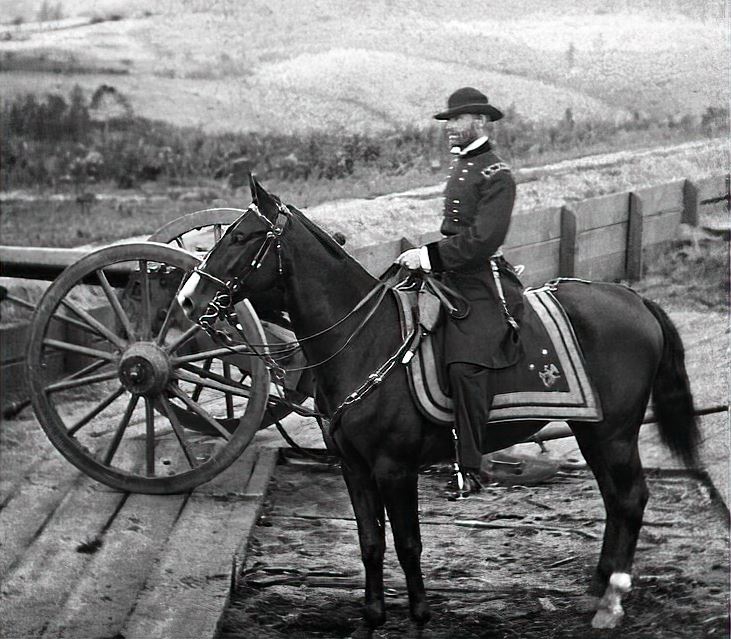
The United States of America Civil War was fought between the “Blue” Union States and the “Grey” Confederate States from 1861 to 1865. The Union military wore blue colored uniforms. The Confederate military wore grey colored uniforms. During the closing time periods of the war, when the South began losing badly, two interesting things occurred. One factor was the Confederate government began asking wealthy Southerners for financial help for gold offerings since the South was in economic shambles and its military needed money to pay for weapons, uniforms, and the salary of the troopers. Another factor is that large sums of gold began to mysteriously disappear from the government Treasury Office of the Confederate States of America to be hidden in secret locations to prevent from being stolen by advancing Union Soldiers.
Southerners strongly believed that even if the South were defeated by the Union Armies,that “the South would rise again” and eventually resume power to reign. And, of course, the Southern government would have to be very wealthy to function again and gold, an international commodity,, would work once Confederate paper currency and coinage became obsolete, illegal, and worthless under the Union government.
In other cases, ordinary Southerners who owned gold were afraid of the Yankees (the Unionists) stealing their gold, and so such gold was hidden away, often buried deep on the property owner’s land.
In the USA Civil War, a great many businesses and plantations were destroyed by the federal government troops to prevent the enemy South from using them economically. Such widespread devastation was especially practiced by the Union General William Tecumseh Sherman (1839-1891) whose “scorched earth” policies destroyed much of Georgia.In certain areas where the Confederates buried gold, there were times where the location was carved in secret codes on the bark of a tree. Puzzling words, symbols, and numbers were often part of the secret writings. Such secret messages would tell only a very small group of trusted “inner circle” people where the treasurers are buried.
There are stories that connect the notorious outlaw, gunslinger, bank robber, train robber, stage coach robber, and mass murderer Jesse James (1847-1882) with Confederate gold. He was raised in a family that was in the “Little Dixie” area of western Missouri that held strong Southern sympathies and white supremacy beliefs. During the USA Civil War, Jesse James and his brother Frank James (1843-1915) joined pro-Confederacy guerillas, known as “the bushwackers” operating in Missouri and Kansas. The James Brothers and others of the militant Confederate group were accused of committing atrocities against Union soldiers and civilian abolitionists, including the Centralia Massacre in 1864.
Jesse James and other members of a clandestine pro -Confederate political organization are said to have buried large quantities of Confederate gold in “depositories” from Ohio to Utah and New Mexico to the nation of Mexico and all the way to Florida to fund a Confederate uprising after the Civil War.
In southwestern Oklahoma, at a certain rock formation called “Buzzard’s Roost” near the small town of Cement,is a starting point where legends say Jesse James and his bandits buried what is today worth millions of dollars in treasure of mainly gold. somewhere in the Keechi Hills. The gold and other high valued items as silver and jewelry, originally came from Mexico by mule pulled wagons.
Jesse James and his family have strong family ties with southwestern Oklahoma and Frank James called the small town of Fletcher, Oklahoma “home”.
Many people believe the gold, silver, and jewelry are still there.There are stories of Confederate gold buried in the state of Georgia. Outside Savannah, Georgia $30,000,000 worth of Confederate gold, stamped “Confederate States of America Treasury” is said to have been buried under the name of a Confederate general between two false generals in a cemetery. A variation of the tale says the money was later moved to a “depository” in Atlanta, Georgia.
Half a million dollars of Confederate gold bullion is said to have been buried in West Central Boward County, Georgia, by Captain of the Confederate Army John Riley, who originally planned to ship it to a secret location in Cuba, but in being pursued by Union officers had the gold buried.
In Georgia in 1865, two wagon trains moving $100,000 in Confederate gold were robbed at Chennault Crossroads in Lincoln County. There appears to be remnants that were left behind, because a certain amount of the gold coins that fell down and eventually went into the ground, and after heavy rains, many gold coins have been found along the road to Chennault Plantation.
The Confederacy once moved, by all accounts, $100,000 in gold coins and silver coins in two large crates, transported by a horse drawn wagon to Columbia, Tennessee. As the wagon neared Athens, Alabama, the vehicle became stuck in a muddy “bog hole”. While the men tried to free the wagon, they were warned of pursuing Union troops. Worried the Union soldiers would steal the treasure, the Confederate officials buried the coinage about a half mile west of an old stream crossing, about four miles north of Athens, Alabama in Limestone County. No- one ever was known to discover that treasure.
In 1865, and after a number of years since then, Southern sympathisers began to bury what is now millions of dollars of gold and silver coins across various sites in the nation of Canada to help pay for a future Confederate States of America Army and government in America.
Certain tales exist of a large cache of gold from the Dixieland government that got buried by Southern loyalists in California somewhere high up in the mountains of the SIerra Nevada region to fund a “second South”.
Tales of hidden “Gold from the South” also abound in the sparse territories of northeastern states that include Oregon and Montana.”Dixie Gold” stories abound concerning being deeply submerged in the frigid, rolling waters of Lake Michigan. Union troops of the fourth calvary in Georgia, confiscated a very large amount of formerly buried Confederate Gold, and high numbers of silver items and jewelry, the Georgians who discovered what happened felt that they were robbed by the Union soldiers. Later on, troops under the command of Brigadier General Robert Horatio George Minty retrieved the massive Dixie accumulation with Minty being in charge of its safekeeping. There are stories that B.General Minty took some of the treasure to have a necklace made for his wife. After the Civil War, Minty went to work as a railroad supervisor. In the 1890’s, the huge remainder of the plundered riches were secretly placed in a boxcar on a ferry, meant to go to the Union troops in Michigan. But the ship met with very stormy weather at Frankfort, Michigan. Some of the boxcars, including the clandestined packed massive wealth boxcar were thrown into the Michigan Lake to greatly lighten the load of the sailing vessel to save it from sinking. Millions of dollars of precious metals and personal collectibles are believed to be still down in the bottom of Lake Michigan.


